Biology
Biology concepts ? parthenogenesis, avian reproductive system
Butthere are gray areas. Take chicken eggs for instance. Most chicken eggs laid by working hens all over the world are not fertilized. We will talk much more about this in a couple of paragraphs.
Rememberthat they must be toms because of the sex determination system of birds. Males are ZZ, while their mothers have ZW sex chromosomes. By producing a diploid ovum (egg cell), the moms would double their own DNA, giving either a ZZ or a WW, but WW?s are nonviable. Therefore, all parthenogens would have to be male.
First off, think of the laying of an egg as the equivalent of a human female?s menstrual cycle. Each month, a woman of child-bearing years will release a mature egg from her ovary (maybe two). In humans, the ovaries trade off each month, but in chickens, only the left ovary and oviduct are functional; the right is there when born, but degenerates over time.
When ovum and mature yolk exit the ovary, they enter the oviduct. The first portion is called the infundibulum, and is where the ovum would be fertilized, if a rooster has been in the hen house recently. Whether or not it has been fertilized, the egg then passes into the magnum, which is about 4 inches or so long. In the magnum, the albumen is added around the yolk and ovum. The albumen is clear and provides protection and nutrients to the embryo. It is 90% water and about 10% protein.
The stimulus for diploid egg production is not known; however, the increase in parthenogenesis in the BSW turkeys after breeding them indicates that there is a genetic component to the development of unfertilized eggs. What that component might be is up for grabs. Maybe the breeding selected for females that have an odd hormone profile, or are more apt to undergo endomitosis in their gametes, or ?.. you find out and get rich.
Parker, H., Kiess, A., Robertson, M., Wells, J., & McDaniel, C. (2012). The relationship of parthenogenesis in virgin Chinese Painted quail (Coturnix chinensis) hens with embryonic mortality and hatchability following mating1 Poultry Science, 91 (6), 1425-1531 DOI: 10.3382/ps.2011-01692
- Sex Determination In Animals
Sex chromosomes and AutosomesMost of the diploid organisms are with separate sexes. The organisms producing sperms are called males and those producing eggs (ova) are called females. Chromosome is the major factor to determine the sex of an organism. The...
- 1. Reproduction In Organisms
Click here for PDF- Reproduction is a process in which an organism gives rise to young ones (offspring) similar to itself. - The period from birth to the natural death of an organism represents its life span. - ...
- A Marriage Of Inconvenience
Biology concepts ? parasitic parthenogenesis, parental sex ratio chromosome Henry the VIII had not quite divorced Catherine by the time Anne Boleyn caught his eye, although she was said to have six fingers and a large mole or goiter on her...
- Just Leave The ?father? Line Blank
Biology concepts ? apomixis, automixis, genomic imprinting, haplodiploid, facultative and obligate parthenogenesis Kids questions can be exasperating, exhilarating, and problematic ?all at the same time. Questions about biology are especially difficult...
- Exceptions Give Birth To Exceptions
Biology concepts ? parthenogenesis, polyploidy, geographic parthenogenesis Komodo dragons are the largest lizards on Earth, reachingmore than 10 ft (3 m) in length and upwards of 300 lb.s (136 kg). It was believed that they used the toxic bacteria in...
Biology
The Yolk?s On You
Biology concepts ? parthenogenesis, avian reproductive system
Some people practice a form of vegetariansim called veganism. The definition of vegan can be different from person to person, but generally it means that one does not consume or use animal products in which an animal was harmed to obtain them.
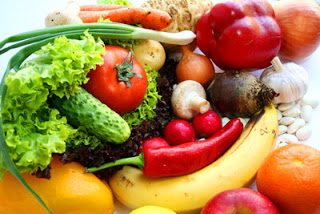 |
Vegans range from those who won?t eat animals or products that require animals to be harmed, to those that will not use any animal product whatsoever. Plants make up their entire diet. How shocked will they be to learn that research has uncovered that plants might well have feelings and sensations. |
Unfertilized eggs can?t develop into a chick. Because of this, some vegans will eat chicken and quail eggs that are certified unfertilized. Now for a potential problem ? chickens, quails, turkeys, and other birds are known to undergo parthenogenesis! Unfertilized eggs might have a partially developed embryo inside them. What is a vegan to do?!
The thought that birds might be able to undergo parthenogenesis is not that strange. Reptiles are the ancestors of bird species, and reptiles are famous for their number of parthenogenic species, both obligate and facultative.
The difference between parthenogenesis in birds and in reptiles is that the bird form rarely, very rarely, ends with a chick hatching from the egg. Most die at some point in development - usually early.
The first species in which bird parthenogenesis was studied was the Beltsville Small White (BSW) Turkey. It was recognized in the 1950?s that this breed had some eggs that had started to develop even though they had not been mated to a male.
The researchers then embarked on a long breeding project in which they increased the number of parthenogenic embryos. By breeding females that had a higher tendency to lay parthenogenic eggs to males from mothers who were more likely to develop parthenogenic eggs, the scientists developed the breed for parthenogens that developed longer and longer.
In some cases (still less than 1%) the parthenogenic eggs would hatch. And some of those turkeys matured fully and lived to a ripe old age! The breed still exists and is still studied, so parthenogenic tom turkeys are born to these females every once in a while.
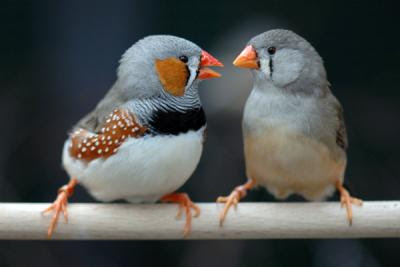 |
Zebra finches are native to central Australia, but have been introduced into North America, Brazil, and Portugal. They are good for research because they can breed all year round, usually after strong rains, they have clutches of five-seven eggs, and they are fast maturing. |
After studies in turkeys were publicized, it was recognized that parthenogenic development was also occurring in chickens. There was a single report of parthenogenesis in a pigeon. Then in the late 2000?s, parthenogenesis in both Chinese Painted Quails and Zebra Finches was recognized. It is important to note that in these later named species, only one parthenogen was noted to survive; that being a chicken in the 1970?s. At that time, molecular methods of genome identification were not available, so we are not sure if this was a true parthenogen.
The other point to note is that these are all domesticated, captive birds. We don?t know if parthenogenesis takes place in birds in the wild. Similar to the cases in other animals, we first recognized parthenogenesis in sharks and komodo dragons in zoos, because that is where people could control if females were exposed to males. Many assumed that parthenogenesis was caused by a lack of males and that they would not give birth from unfertilized eggs in the wild. We now know that isn?t true for komodos, and we have the report showing that pit vipers will undergo parthenogenesis in the wild, even if males are present. Who knows if this is the case for birds.
To understand parthenogenesis in birds, it would help to look at how eggs are produced; we?ll use the chicken as a model. Some weird things can happen with chicken eggs and their process of production is responsible for most of these oddities.
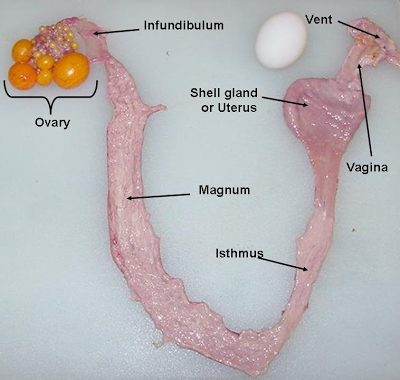 |
This isn?t the most pleasant of pictures, but it shows the reproductive tract well. The yellow orbs on the left are the ova with developing yolk in the ovary. The bigger ones will be released first. The magnum is larger and adds albumen; the isthmus is narrower and adds the membranes. Guess what the shell gland does. The finished eggs exit via the vent. |
If the human egg is fertilized, the embryo will implant into the wall of the uterus and the placenta will develop. If not, the uterine environment will flush itself out each month and the cycle will begin again. This is different in chickens. Whether the egg is fertilized or not, the ovum (and attached yolk) will be sent on along the oviduct and an egg will be formed.
Chicks are born with 13,000-14,000 ova and they produce no more. Not all will be laid as eggs, but every 26 hours or so, a new ovum with developed yolk (fatty nutrients for the developing chick) will be released from the ovary. The timing of the release is actually controlled by the laying of the egg. When an egg is laid, a new ovum will be released about 30-60 minutes later.
Ovulation is also controlled by the amount of sunlight in the day. Summer day lengths stimulate ovulation, so egg producers manipulate the lights so the hens always think it is summer.
Of course, there is an exception to this. Chickens won?t ovulate after about 3:00 pm! They must where watches. And the entire process for laying an egg takes about 26 hours. This is longer than a day ? duh - so each day the chicken will ovulate about 2 hours later. This keeps up until she would be due to ovulate after 3:00. In this case, she just won?t do it, and will wait until the next morning to ovulate. As a result, a chicken will not lay an egg once every six days or so.
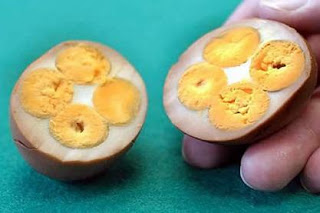 |
Double yolks aren?t really that uncommon, occurring in about 1in 1000 eggs. However, they are usually caught in the production process and used for other egg products instead of putting them in your Styrofoam box. Quadruple yolks are much less common, but they do occur, and some breeds are more likely to give them than others. |
After the magnum is the isthmus. This is where the egg is surrounded by the inner and outer membranes. The next stop is the shell gland, and you can guess what is added here. The calcium carbonate shell takes about 20 hours to form around the egg, so this is where the egg spends the majority of its time. Then it is laid by being squeezed out with muscle movement.
Like I mentioned above, weird things can happen during this 25-27 inch trek through the chicken. Sometimes two ova may be released at once. These can both be surrounded by a single albumen and shell and come out as a double yolk egg. There are instances where one or both yolks may be fertilized, but the lack of space and nutrients usually leads to at least one of the chicks dying in the shell, and usually both. The record is nine yolks in a single egg!
On a different note, when the hen is young no ovum may be released, and a small piece of loose tissue could be mistaken for an ovum. In this case, it will be wrapped in albumen, membranes and shell, and a yolkless egg will be produced. I have a student who is seriously considering investigating a way to manipulate chickens to give yolkless eggs all the time ? could be a million dollar idea.
There was a recent story that illustrated one more weird possibility. If the muscular movement shoots the egg backward instead of out, it can happen that the developed egg will go through another round of the process. It can also meet up with the next developing ovum. In this case, the developed egg could be surrounded with more albumen, membrane, and then be wrapped in another shell - an egg within an egg! Don?t believe me? Watch the video.
In parthenogenesis, the ovum + yolk will be diploid, the result of endomitosis or fusion of two ova. They will be sent along the path of egg production, and once laid, they look like regular eggs. The embryo will not develop beyond three days or so, so they are hard to tell from unfertilized eggs or those eggs that are fertilized and undergo spontaneous early embryonic death. You probably wouldn?t know if you were eating one.
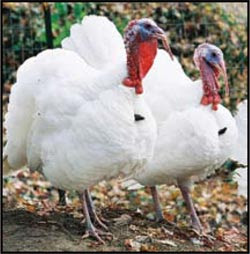 |
The Beltsville Small White turkey was developed in the 1930?s and quickly became the most popular turkey on American plates. The name comes from the USDA research farm n Beltsville Maryland, where they were developed. However, in the 1940?s the broad breast turkey was bred and the BSW quickly faded, except for in research ? they have high rates of parthenogenesis! That should keep them popular. |
In the BSW turkeys, breeding led to later development and finally some live hatchings. This is now being tried in quails as well. Dr. C.D. McDaniel at Mississippi State University is investigating the idea that parthenogenic development actually reduces the hen?s ability to hatch fertilized eggs.
After nine generations of cross breeding females and males to increase parthenogenic development, McDaniel reported in late 2012 that quail that have more parthenogenic events do indeed have fewer fertilized eggs that hatch and develop to mature quails. Late embryonic death decreased, but early death increased dramatically. This is a significant economic question, as it would seem that lower rates of parthenogenesis will lead to greater production of quails.
Next week, we will see that parthenogenesis is not always the ?choice? of the female. Sometimes, parthenogenesis can be forced on an animal.
- Sex Determination In Animals
Sex chromosomes and AutosomesMost of the diploid organisms are with separate sexes. The organisms producing sperms are called males and those producing eggs (ova) are called females. Chromosome is the major factor to determine the sex of an organism. The...
- 1. Reproduction In Organisms
Click here for PDF- Reproduction is a process in which an organism gives rise to young ones (offspring) similar to itself. - The period from birth to the natural death of an organism represents its life span. - ...
- A Marriage Of Inconvenience
Biology concepts ? parasitic parthenogenesis, parental sex ratio chromosome Henry the VIII had not quite divorced Catherine by the time Anne Boleyn caught his eye, although she was said to have six fingers and a large mole or goiter on her...
- Just Leave The ?father? Line Blank
Biology concepts ? apomixis, automixis, genomic imprinting, haplodiploid, facultative and obligate parthenogenesis Kids questions can be exasperating, exhilarating, and problematic ?all at the same time. Questions about biology are especially difficult...
- Exceptions Give Birth To Exceptions
Biology concepts ? parthenogenesis, polyploidy, geographic parthenogenesis Komodo dragons are the largest lizards on Earth, reachingmore than 10 ft (3 m) in length and upwards of 300 lb.s (136 kg). It was believed that they used the toxic bacteria in...
